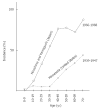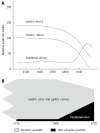History of Helicobacter pylori, duodenal ulcer, gastric ulcer and gastric cancer
- PMID: 24833849
- PMCID: PMC4017034
- DOI: 10.3748/wjg.v20.i18.5191
History of Helicobacter pylori, duodenal ulcer, gastric ulcer and gastric cancer
Abstract
Helicobacter pylori (H. pylori) infection underlies gastric ulcer disease, gastric cancer and duodenal ulcer disease. The disease expression reflects the pattern and extent of gastritis/gastric atrophy (i.e., duodenal ulcer with non-atrophic and gastric ulcer and gastric cancer with atrophic gastritis). Gastric and duodenal ulcers and gastric cancer have been known for thousands of years. Ulcers are generally non-fatal and until the 20th century were difficult to diagnose. However, the presence and pattern of gastritis in past civilizations can be deduced based on the diseases present. It has been suggested that gastric ulcer and duodenal ulcer both arose or became more frequent in Europe in the 19th century. Here, we show that gastric cancer and gastric ulcer were present throughout the 17th to 19th centuries consistent with atrophic gastritis being the predominant pattern, as it proved to be when it could be examined directly in the late 19th century. The environment before the 20th century favored acquisition of H. pylori infection and atrophic gastritis (e.g., poor sanitation and standards of living, seasonal diets poor in fresh fruits and vegetables, especially in winter, vitamin deficiencies, and frequent febrile infections in childhood). The latter part of the 19th century saw improvements in standards of living, sanitation, and diets with a corresponding decrease in rate of development of atrophic gastritis allowing duodenal ulcers to become more prominent. In the early 20th century physician's believed they could diagnose ulcers clinically and that the diagnosis required hospitalization for "surgical disease" or for "Sippy" diets. We show that while H. pylori remained common and virulent in Europe and the United States, environmental changes resulted in changes of the pattern of gastritis producing a change in the manifestations of H. pylori infections and subsequently to a rapid decline in transmission and a rapid decline in all H. pylori-related diseases.
Keywords: Antiquity; Atrophic gastritis; Duodenal ulcer; Epidemiology; Gastric cancer; Gastric ulcer; Gastritis; Helicobacter pylori; Medical history; Ulcer surgery.
Figures








References
-
- Moynihan BGA. History. Peptic ulcer. Philadelphia: WB Saunders; 1910. pp. 17–23.
-
- Goldstein HI. Ulcer and cancer of the stomach in the middle ages. J Internal Coll Surgeons. 1943;6:482–489.
-
- Cheng TO. Glimpses of the past from the recently unearthed ancient corpses in China. Ann Intern Med. 1984;101:714–715. - PubMed
-
- Wilber DL. The history of diseases of the stomach and duodenum with reference also to their etiology. In: Eusterman GB, Balfour DC, editors. The stomach and duodenum. Philadelphia: WB Saunders Company; 1935. pp. 1–21.
Publication types
MeSH terms
Grants and funding
LinkOut - more resources
Full Text Sources
Other Literature Sources
Medical
Miscellaneous

